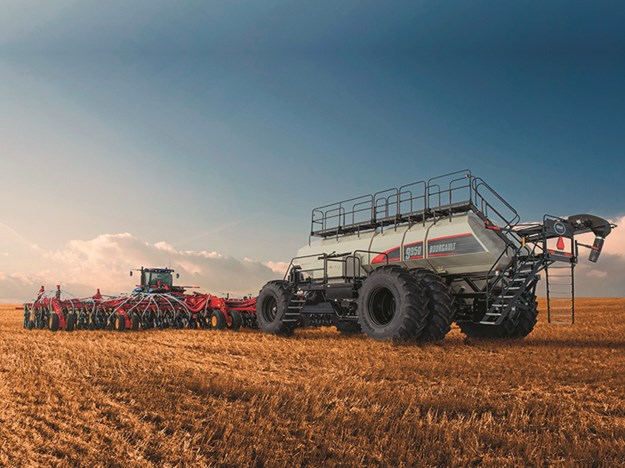Canada’s Bourgault shares its advice for how you can get the most out of your air seeder
Bourgault has been manufacturing air seeders for more than 40 years and with experience comes knowledge.
The Canadian company, with a strong local presence through Bourgault Australia, introduced the world’s first tow-behind seeder in 1980 and has an in-house agronomy team that aims to keep it at the forefront of innovation.
Involving a mixture of smart planning and capitalising on technological advances in machinery, Bourgault shares its top 10 tips for how farmers can best utilise their air seeder.
 |
|
Bourgault’s 9950 trailing air seeder
|
Input costs
Rising input costs can take away the profit from all your hard work, so the desired solution is to mitigate recent increases in costs of seeds and fertilisers without negatively impacting yield.
The best way to increase the value of high-cost inputs is to increase efficiency by putting exactly the right amount on without waste.
A lot of agronomy research goes into finding the best rates for each crop, paddock or soil type, so it’s important that a seeder is applying the rates you want it to.
Correct calibration
New technologies like variable rate application allow users to adjust the input rates automatically across the paddock in line with a pre-loaded prescription map.
The accuracy of the output, however, is only as accurate as the seeder being used. Errors in the seeding rate can come from a variety of sources, beginning at calibration. If your calibration is out, everything after that will also be out, potentially costing you in both wasted input costs and reduced yield at harvest. Calibrating correctly is the key.
Weigh to fix it
A seeder with individual weigh scales on each tank allows for the most accurate calibration on the market today.
When integrated with a touchscreen seed-rate controller, modern seeders can tell you exactly how much product is in the tank. Those with the latest in seeding technology will also give you a live reading with on-the-go calibration, ensuring you are putting on the exact amount of product you want.
Technological tweaks
Once the seeder is calibrated, it is important the metering units are both accurate and capable of achieving the range of rates you want.
With an easily adjustable three-speed gear range and a variety of internal metering augers, the PDM Pro from Bourgault is one of the most simple and reliable metering units on the market.
Whether you are trying to meter 2kg per hectare or 200kg per hectare, the electronically controlled hydraulic drive metering units are both accurate and versatile, requiring minimal adjustment between products.
Extra efficiency
For further input savings, auto section control (ASC) is now a common feature.
The ability to turn off sections of a bar when travelling over already seeded ground is necessary to reduce overlap and wasted product.
Dual ASC for both fertiliser and seed inputs will give you the greatest savings.
For the greatest savings on expensive input costs, a complete system with real-time calibration from individual tanks, reliable and accurate metering units and dual ASC will give you the best seeding efficiency possible.
Scattered not clumpy
To ensure even emergence from your crops, it is important the seeds are then distributed evenly across the entire bar rather than too closely together.
Bourgault’s Evenstream distribution system places special centring vanes and plastic inserts above the primary manifold to achieve even and consistent coverage across the entire bar.
Think big
If you really want to maximise your seeding time, bigger seeders are a good way to keep seeding for longer.
The world’s largest production seeder, the 91300 from Bourgault, comes in at a little over 45,000L, meaning most farmers will not require quite that capacity.
Seeders in the same 9000 I Series range, with the same features, start at 22,000L and
Bourgault’s 9950 trailing air seeder come in both leading and trailing configurations. These come standard with four tanks and an optional fifth saddle tank, meaning your seeder becomes more versatile and ideal for a range of crops and seeding programs.
Negating ground impact
If you are concerned about the impact a large seeder can have on your paddock, the simplest solution is larger tyres.
New innovations in tyres mean that large diameter, increased inflexion tyres deliver very low ground pressures, reduced rolling resistance, and maximise flotation, which helps to ensure uniform germination and reduced compaction.
Getting it done
Like pit stops in a car race, filling your seeder needs to be efficient and fast so you can get back seeding as soon as possible.
The ability to fill your seeder quickly, while still being gentle on seed, means that conveyors are no longer an optional extra but now standard equipment on modern seeders.
Remote-controlled hydraulic positioning makes the process easy and efficient for any operator, allowing you to seed more hectares per day.
Seeders in sync
Large-scale farmers will recognise the benefits of having more than one seeding rig in a paddock at the same time but know the struggle of not being able to synchronise your seeding progress onto a single map.
Features like I2I from Bourgault gives you the ability to share field coverage between two or more seeders.
This allows all operators to view which areas of the paddock are seeded, avoid misses and have one complete coverage map when the paddock is complete.

